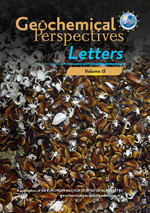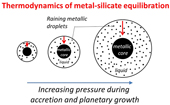 | Activity coefficients of siderophile elements in Fe-Si liquids at high pressure Abstract: Metallic core formation in differentiated bodies in the inner solar system can take place between low pressures (near 1 bar) to much higher pressures (up to 100 GPa). Most thermodynamic models of metal-silicate equilibria utilise activity coefficients for metallic tracers in Fe liquids, nearly all of which have been carried out at low pressures. This study focuses on the effect of pressure on activity coefficients for Au, P, V, Mn, Ga, Zn, Cd, Sn, W, Pb, and Nb in liquid Fe-Si alloys. From a series of experiments at 10 GPa, 2373 K containing variable Si content in a metallic liquid we have derived epsilon interaction parameters in Fe-Si liquids (). Comparison of 1 GPa and 10 GPa data shows no difference except for Nb. Epsilon parameters derived from low pressure experiments can thus be used to calculate activity coefficients for application to higher pressure processes (at least to 10 GPa). |
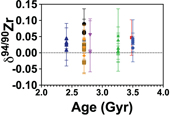 | Zirconium isotopic composition of the mantle through time Abstract: Zirconium isotopes have the potential to trace both magmatic differentiation and crustal evolution, as well as deep Earth processes. Zirconium is compatible in bridgmanite where it has a higher coordination number than in silicate melt, implying that Zr isotopes could be fractionated during magma ocean crystallisation. We report the Zr isotopic composition of 31 komatiites from around the globe, ranging in age from 2.41 to 3.55 Ga. The δ94/90Zr (per mille deviation of 94Zr/90Zr from IPGP-Zr standard) values for the komatiites are homogeneous at 0.030 ± 0.049 ‰ (all errors are 2 s.d.), and consistent with associated basaltic rocks (0.048 ± 0.032 ‰). These results, identical within uncertainty of the bulk silicate Earth estimate from modern basalts, suggest that the mantle Zr isotope composition has been constant since at least 3.55 Ga. Combining the isotopic compositions of komatiites and basalts of all ages we suggest a conservative δ94/90Zr = 0.040 ± 0.044 ‰ (n = 72) for the mantle composition. Several komatiite systems that we analysed in this study, including Schapenburg, Komati, and Weltevreden, have been previously argued to have isotope signatures consistent with magma ocean crystallisation processes. However, their Zr isotope compositions are indistinguishable from other komatiites, implying that bridgmanite crystallisation did not fractionate Zr isotopes to any measurable extent. |
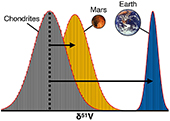 | The vanadium isotope composition of Mars: implications for planetary differentiation in the early solar system Abstract: The V isotope composition of martian meteorites reveals that Bulk Silicate Mars (BSM) is characterised by δ51V = −1.026 ± 0.029 ‰ (2 s.e.) and is thus ∼0.06 ‰ heavier than chondrites and ∼0.17 ‰ lighter than Bulk Silicate Earth (BSE). Based on the invariant V isotope compositions of all chondrite groups, the heavier V isotope compositions of BSE and BSM relative to chondrites are unlikely to originate from mass independent isotope effects or evaporation/condensation processes in the early Solar System. These differences are best accounted for by mass dependent fractionation during core formation. Assuming that bulk Earth and Mars both have a chondritic V isotopic compostion, mass balance considerations reveal V isotope fractionation factors Δ51Vcore-mantle as substantial as −0.6 ‰ for both planets. This suggests that V isotope systematics in terrestrial and extraterrestrial rocks potentially constitutes a powerful new tracer of planetary differentiation processes accross the Solar System. |
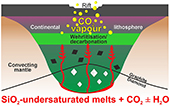 | Wehrlites from continental mantle monitor the passage and degassing of carbonated melts Abstract: Continental rifting has been linked to the thinning and destruction of cratonic lithosphere and to the release of enough CO2 to impact the global climate. This fundamental plate tectonic process facilitates the infiltration and mobilisation of small-volume carbonated melts, which may interact with mantle peridotite to form wehrlite through the reaction: enstatite + dolomite (melt) = forsterite + diopside + CO2 (vapour). Application to mantle xenolith suites from various rifts and basins shows that 2.9 to 10.2 kg CO2 are released per 100 kg of wehrlite formed. For the Eastern Rift (Africa), this results in estimated CO2 fluxes of 6.5 ± 4.1 Mt yr−1, similar to estimates of mantle contributions based on surficial CO2 surveys. Thus, wehrlite-bearing xenolith suites can be used to monitor present and past CO2 mobility through the continental lithosphere, ultimately with diffuse degassing to the atmosphere. They may also reveal the CO2 flux in lithospheric provinces where carbonated melts or continent-scale rifts are not observed at the surface. |
 | Fate of organic compounds during transformation of ferrihydrite in iron formations Abstract: The absence of organic compounds from Precambrian iron formations (IF) challenges the hypothesis of the biogenic origin of IF. Here we address the fate of adsorbed organic compounds during transformation from ferrihydrite to hematite. We determined the binding energy between hematite and common molecular terminations found in extracellular polymeric substances and biofilms: carboxylic, hydroxyl and phosphate functional groups. We found that the bond between hematite and hydroxyl groups is approximately 2 times stronger than the bond between hematite-carboxyl and -phosphate groups. We transformed synthetic ferrihydrite to hematite at 90 °C in presence of glycerol, which has a high density of hydroxyl groups, and measured the amount of mineral associated glycerol before and after the transformation. We show that the transformation releases glycerol highlighting that organic compounds adsorbed at precursor ferrihydrite could be desorbed during the process of IF sedimentation and diagenesis. Our results suggest that the absence of organic compounds in IF should not be used as evidence against their biogenic origin. |
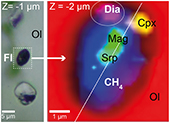 | Diamond forms during low pressure serpentinisation of oceanic lithosphere Abstract: Diamond is commonly regarded as an indicator of ultra-high pressure conditions in Earth System Science. This canonical view is challenged by recent data and interpretations that suggest metastable growth of diamond in low pressure environments. One such environment is serpentinisation of oceanic lithosphere, which produces highly reduced CH4-bearing fluids after olivine alteration by reaction with infiltrating fluids. Here we report the first ever observed in situ diamond within olivine-hosted, CH4-rich fluid inclusions from low pressure oceanic gabbro and chromitite samples from the Moa-Baracoa ophiolitic massif, eastern Cuba. Diamond is encapsulated in voids below the polished mineral surface forming a typical serpentinisation array, with methane, serpentine and magnetite, providing definitive evidence for its metastable growth upon low temperature and low pressure alteration of oceanic lithosphere and super-reduction of infiltrated fluids. Thermodynamic modelling of the observed solid and fluid assemblage at a reference P-T point appropriate for serpentinisation (350 °C and 100 MPa) is consistent with extreme reduction of the fluid to logfO2 (MPa) = −45.3 (ΔlogfO2[Iron-Magnetite] = −6.5). These findings imply that the formation of metastable diamond at low pressure in serpentinised olivine is a widespread process in modern and ancient oceanic lithosphere, questioning a generalised ultra-high pressure origin for ophiolitic diamond. |
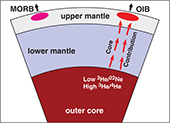 | Potential of Earth’s core as a reservoir for noble gases: Case for helium and neon Abstract: This study investigates metal–silicate partitioning of neon (DNe) under the likely conditions of early Earth’s core formation: up to 16 GPa, ∼ 3000 K and an oxygen fugacity near IW-2 (2 log units below the Iron-Wüstite buffer). We find that the DNe coefficients range between 10−2 and 10−1. These partition coefficients are only one of the controlling factors of noble gas distributions within the early Earth: because, even if DHe and DNe are low (∼10−4), there may have been sufficient noble gases present in the mantle to supply a significant quantity of He and Ne to the core. Assuming gas-melt equilibrium of the molten proto-Earth with a nebular gas composition and concomitant metal-silicate differentiation, the core would have inherited and maintained throughout Earth’s history high 3He/4He ratios and low 3He/22Ne ratios (<0.6), making the core a potential source of primordial light noble gases in mantle plumes. |
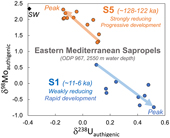 | Rapid onset of ocean anoxia shown by high U and low Mo isotope compositions of sapropel S1 Abstract: Authigenic uranium isotope compositions of Holocene sapropel S1 (δ238Uauth = +0.10 to +0.52 ‰; ODP core 967, 2550 mbsl) are significantly higher than the proposed upper boundary (+0.2 ‰) associated with the transport-porewater diffusion model for sediment uranium uptake. It is shown that these high δ238Uauth values are compatible with rapid initial slowdown of thermohaline overturning and the development of an anoxic water column. These conditions would favour U uptake in an organic-rich floccule layer overlying the sediment-water interface. The high δ238Uauth values correlate with low δ98Moauth values (+0.02 to −0.88 ‰), interpreted to reflect weakly euxinic conditions controlled by thiomolybdate–molybdate solution equilibria. The S1 data contrast markedly with published data from last interglacial sapropel S5 from the same core, which show δ238Uauth and δ98Moauth characteristics compatible with a restricted euxinic basin due to progressive slowdown in the thermohaline circulation. The U-Mo isotope data for S1 are similar to a range of published palaeo-settings. Sapropels are therefore shown to be useful templates for the unravelling of the interplay between productivity and deep water renewal times in ancient settings. |
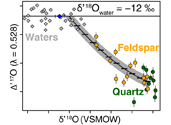 | Triple oxygen isotopes of meteoric hydrothermal systems – implications for palaeoaltimetry Abstract: We use triple oxygen isotopes of altered granitic rocks to determine the isotope composition of meteoric waters in a fossil hydrothermal system, the low δ18O Eocene Idaho Batholith, originally studied by Criss and Taylor (1983). In doing so we: 1) test whether meteoric water values estimated from previous δ18O and δD analyses on quartz, feldspar and biotite are robust and 2) determine the palaeoelevation of the Eocene highlands that are presently constrained primarily by the δ18O and δD of paired muscovite and quartz from core complexes and altered granites. Our calculated δ18O values of meteoric water are higher than estimates that use combined feldspar δ18O and biotite δD measurements in these hydrothermally altered granites and δD values from muscovite from nearby core complexes (Mulch et al., 2004). Both methods are consistent with a high elevation (∼3.1 to 4.7 km) Eocene highland in the northwestern U.S. Cordillera. |
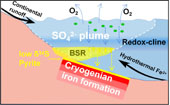 | Termination of Cryogenian ironstone deposition by deep ocean euxinia Abstract: Widespread deposition of iron-rich sedimentary rocks (ironstones) occurred during the Sturtian ice age, the earlier of two Cryogenian ‘Snowball Earth’ glaciations. However, the reasons for the termination of Cryogenian Iron Formation (CIF) deposition remain poorly understood. Here we report a multi-isotope (Fe-C-S) study of the Xinyu CIF in South China that can directly address this question. The isotopic compositions of these multivalent elements exhibit remarkable covariance at the top of the Xinyu CIF that reflects progressive redox stratification during iron oxide deposition. Iron oxide deposition ended abruptly due to the titration of ferrous iron as pyrite following a large influx of riverine sulfate. Although termination of CIF deposition is commonly attributed to oxygenation, our data show that at least in some Cryogenian ocean basins, CIF deposition ended with the spread of euxinic rather than oxygenated waters. |
<< Previous issueNext issue >>





